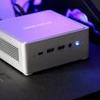Introduction
MINISFORUM has expanded its product lineup with the introduction of the NAB9 mini PC, following the previous releases of the NAB6 in March 2023 and the NAB7 in January 2024. The NAB9 extends to its predecessors, offering enhanced performance and versatility. It is presented in three different configurations, all powered by the Intel Core i9-12900HK processor, which marks a significant upgrade from the Core i7 processors used in the NAB6 and NAB7 models. The NAB9 maintains a consistent array of connectivity options as seen in the NAB6 and NAB7, including two SO-DIMM slots for memory expansion, an M.2 2230 slot designated for modem installation, an M.2 2280 slot for PCIe 4.0 storage, a 2.5-inch drive bay supporting SATA 3.0 drives. The device is equipped with a comprehensive set of ports, including a 3.5mm headphone/microphone combo jack, DMIC, two HDMI outputs, dual RJ45 2.5 Gigabit Ethernet ports, four USB 3.2 Gen2 Type-A ports, and three USB 3.2 Gen1 Type-C ports with varying functionalities including data transfer, DisplayPort Alt Mode, and Power Delivery.Performance-wise, the Core i9-12900HK processor within the NAB9 is anticipated to offer proper desktop performance. Pricing for the NAB9 starts at $359 for the bare-bones model. MINISFORUM also offers configurations with 32 GB of RAM paired with either 512 GB or 1 TB of storage, priced at $479 and $509 respectively.
| Specifications | |
|---|---|
| Processor | Intel Core i9-12900HK Processor, 14 Cores/20 Threads (24M Cache, up to 5.0 GHz) |
| Graphics | Intel Iris Xe Graphics |
| Memory | DDR4 8GB×2 Dual channel (SODIMM Slots×2, up to 64GB) |
| Storage | M.2 2280 512GB PCIe4.0 SSD (up to 2TB) |
| Storage Expansion | 2.5 inch SATA HDD Slot ×1 (SATA 3.0 6.0Gb/s) |
| Wireless Connectivity | M.2 2230 WIFI Support (Wi-Fi, Bluetooth) |
| Video Output | HDMI (4K@60Hz) ×2, USB-C(4K@60Hz) ×2 |
| Audio Output | HDMI ×2, 3.5mm Combo Jack ×1 |
| Ports & Buttons |
RJ45 2.5 Gigabit Ethernet Port ×2 USB3.2 Gen1 Type-C ×1 (Data Only, In Front) USB3.2 Type-C ×1 (DP Only) USB3.2 Type-C ×1 (Alt DP and Data and PD Out) USB3.2 Gen2 Type-A ×4 HDMI ×2 DMIC ×1 3.5mm Combo Jack ×1 Clear CMOS ×1 |
| Power | DC 19V (Adapter Included) |
| System | Windows 11 |
Core i9-12900HK processor
Launched in January 2022, the Intel Core i9-12900HK is a mobile processor positioned within the high-performance segment of the market, leveraging the Alder Lake architecture. This CPU features a hybrid configuration of 14 cores, consisting of 6 performance-oriented cores (P-cores) based on the Golden Cove architecture and 8 efficiency-focused cores (E-cores) based on the Gracemont architecture. The P-cores, supporting Hyper-Threading, enable the processor to handle up to 20 threads simultaneously. The i9-12900HK operates with a base frequency of 2.5 GHz, which can actually be boosted up to 5 GHz for the P-cores, and 1.8 to 3.8 GHz for the E-cores. The processor integrates 24 MB of L3 cache, enhancing data retrieval speeds and overall efficiency. As part of the K-series, it features an unlocked multiplier, offering users the capability for overclocking to achieve higher performance levels. This model is built on Intel's 10 nm process technology, referred to as Intel 7, aiming for improved energy efficiency. With a Thermal Design Power (TDP) of 45 W, the processor aligns with typical power consumption standards for contemporary mobile CPUs, and it can reach up to 115 W under turbo conditions. It supports a range of memory types, including DDR5-4800 and DDR4-3200, among others, via a dual-channel interface. The i9-12900HK is equipped with Intel Iris Xe Graphics, featuring 96 Execution Units (EUs) and capable of reaching speeds up to 1.45 GHz. This integrated GPU supports various decoding capabilities, including HEVC, AVC, and AV1, catering to a range of multimedia applications. From a connectivity standpoint, the processor supports PCI-Express Gen 4, enabling direct links with essential components such as GPUs and SSDs. It includes hardware-level enhancements such as Thread Director for optimal thread allocation between P-cores and E-cores, GNA 3.0 and DL Boost for AI acceleration, and hardware virtualization features to improve the performance and efficiency of virtual machines.


